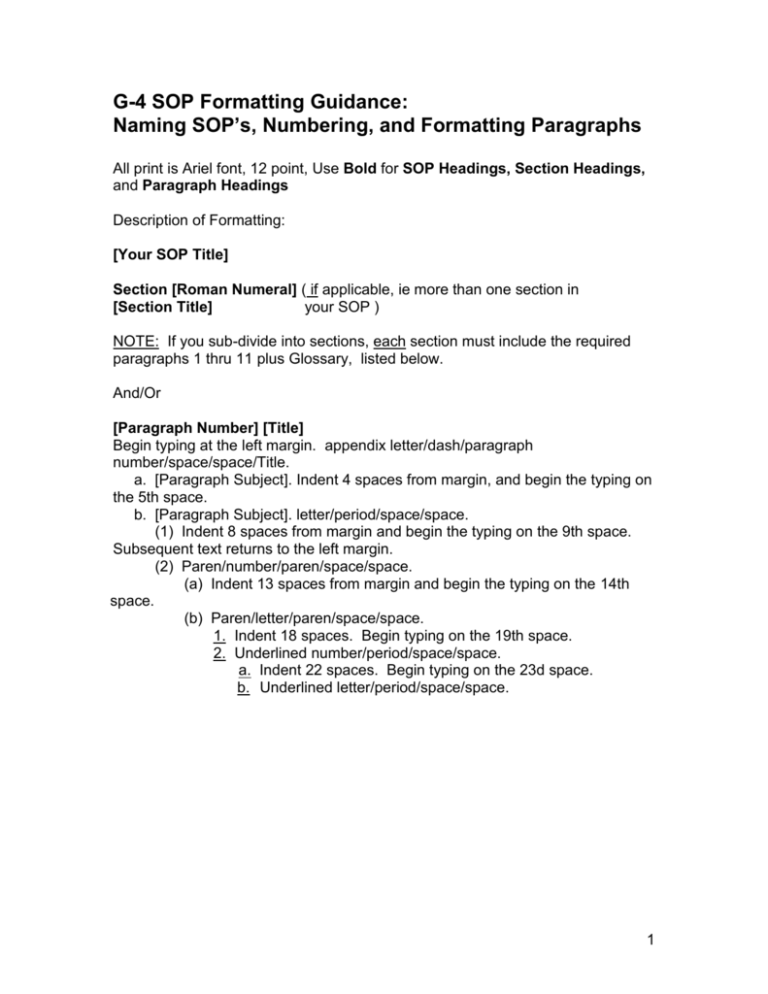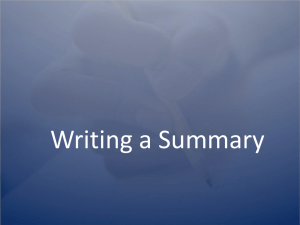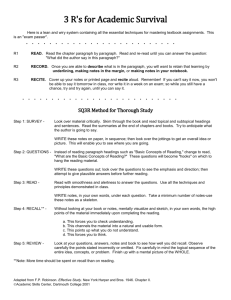SOP Formatting Guide
advertisement

G-4 SOP Formatting Guidance: Naming SOP’s, Numbering, and Formatting Paragraphs All print is Ariel font, 12 point, Use Bold for SOP Headings, Section Headings, and Paragraph Headings Description of Formatting: [Your SOP Title] Section [Roman Numeral] ( if applicable, ie more than one section in [Section Title] your SOP ) NOTE: If you sub-divide into sections, each section must include the required paragraphs 1 thru 11 plus Glossary, listed below. And/Or [Paragraph Number] [Title] Begin typing at the left margin. appendix letter/dash/paragraph number/space/space/Title. a. [Paragraph Subject]. Indent 4 spaces from margin, and begin the typing on the 5th space. b. [Paragraph Subject]. letter/period/space/space. (1) Indent 8 spaces from margin and begin the typing on the 9th space. Subsequent text returns to the left margin. (2) Paren/number/paren/space/space. (a) Indent 13 spaces from margin and begin the typing on the 14th space. (b) Paren/letter/paren/space/space. 1. Indent 18 spaces. Begin typing on the 19th space. 2. Underlined number/period/space/space. a. Indent 22 spaces. Begin typing on the 23d space. b. Underlined letter/period/space/space. 1 Paragraph Subjects within your SOP (and Sections) Following are the required subject (paragraph) headings for paragraphs in your SOP. Required numbering, formatting, and contents for each paragraph are described below. When writing the complete text, refer to the format described above. Required Subject Headings: 1. Mission 2. References 3. Explanation of Terms 4. Responsibilities 5. Policies 6. Procedures 7. Figures 8. Tables 9. Forms 10. Check Lists 11. POC’s Glossary 2 The following information explains how to number, and what to include, in each paragraph: [Your SOP Title] 1. Mission (top of page following Table of Contents page) The Mission paragraph is a one sentence statement describing what your organization does to contribute to the mission of the next higher headquarters. Example: Army South Mission – US Army South, as the Army Service Component Command of U.S. Southern Command (SOUTHCOM), conducts Theater Security Cooperation activities, supports the Global War on Terrorism, and supports contingency operations in order to promote democratic values and prosperity throughout the region, enhance regional stability, and deter and defeat transnational threats to the United States Army South G-4 Mission 1. Mission The mission of the US Army South G-4 Directorate is to conduct Combat Service Support operations in support of Theater Security Cooperation activities within the US Southern Command Joint Operations Area (JOA); O/O deploys with a Joint Task Force (JTF) or Joint Force Land Component Command (JFLCC), to conduct J-4 operations. 2. References List and number references in the order they appear in the SOP. When references do not appear in the text of the SOP, list them in ascending date order (oldest to most recent). Include the following information as a minimum: a. Publications. When listing publications, include the number, title, and date, for example, AR 25–50, Preparing and Managing Correspondence, 21 Nov 88; and (for a supplement and change) USASC, Suppl 1, 3 Mar 95, to AR 710–2, Inventory Management Supply Policy Below the Wholesale Level, 31 Oct 97. b. Correspondence. When referencing to correspondence, include the type of correspondence, organization of origin, office symbol, date, and the subject of the correspondence, for example, Memorandum, HQ USAMC, AMCIO–F, 20 Feb 88, subject: Training for AMC Personnel; and Message, HQ TRADOC, ATPL–TD–OR, 101623Z Sep 84, subject: Correspondence Management. When referencing e-mail or facsimiles, use the name of the sender and the office symbol (if included), for example, E-mail, HQ TRADOC (ATPL–TD–OR), Mr. Sam Jones, 3 Nov 96, subject: Correspondence Management; and Fax, HQ FORSCOM, Ms. Ella Johns, 25 Feb 97, subject: Copier Management. 3 c. Referencing classified material. Use the following guidelines when referencing unclassified material in a classified document or referencing classified material in a classified or unclassified document. (1) When the reference contains classified information or is required to be placed within a classified document, portion-mark the reference and the subject of the reference with the appropriate classification symbol. See AR 380–5 for guidance. (2) When referencing a classified document in unclassified correspondence, show the classification of both the referenced material and the subject, for example, Secret message, HQ TRADOC, ATCG, 201623Z Sep 94, subject: Correspondence Management (U). 3. Explanation of Terms The abbreviations and terms paragraph is always inserted as paragraph “3. Explanation of abbreviations and terms” and always refers the reader to the glossary. The following paragraph is an example of an abbreviations and terms paragraph: 3. Explanation of abbreviations and Terms Abbreviations and special terms used in this SOP are explained in the Glossary. 4. Responsibilities a. Content. In the responsibilities paragraph, identify the individuals who must carry out the policies and procedures prescribed by the publication, and specify the functions each person must perform. When writing a responsibilities paragraph, keep the following guidance in mind: (1) Identify the individual positions and list their specific primary functions. Avoid explaining in detail what the functions are or how to do them. These details should be explained elsewhere in the publication. (2) Identify duty titles or positions, not organizations. If responsibilities are to be assigned to an entire organization rather than to specific people within it, name the head of the organization. It is understood that he or she is ultimately responsible for the performance of the functions but will not perform them personally. If the term commander is used, specify the level of command (for example, unit commander or MACOM commander). (3) State the person’s specific duties. Avoid using vague language. b. Format. List the individuals and their functions according to the chain of command; identify the person at the highest level first and then proceed down through the chain. If several individuals are at the same level, list them according to the size or importance of their responsibilities, naming the one with the most responsibility first. Individuals at the same organizational level are listed in protocol order. A sample responsibility paragraph follows: 4 4. Responsibilities a. The Administrative Assistant to the Secretary of the Army (AASA) will— (1) Serve as the senior Army official for publishing and printing regulations and directives. (2) Serve as the senior Army policy official for Army-wide publications and printing. (3) Serve as the DA functional proponent for information management and the management of information systems (including publications and printing). 5. Policies a. Content. Policies and procedures are the main contents of the body of an administrative publication. Most of the paragraphs, sections, and chapters of a publication explain policies and procedures. Policies are general courses of action to be taken. Procedures are an orderly series of specific actions taken to carry out policy. For example, policy on requisitioning publications may include an explanation of what requisitioning is, the units that may do it, when they may do it, the items they may order, where they order them from, and what order form to use. Procedures may include step-by-step instructions on how to become eligible to order publications, how to fill out the order form, and how to submit orders. b. Organization. There is no unique organization, wording, or format for policies and procedures. Organize and write policies and procedures using command language and style. (1) Policies and procedures are specific divisions of a publication. (2) Policies and procedures should be separate. Generally, explain a policy fully before expanding on the implementing procedures. 6. Procedures a. Types. Three types of procedures are explained in administrative publications: procedures for carrying out a specific action (for example, how to requisition a publication), instructions for preparing a form, and instructions for preparing a report. The following paragraphs explain the placement of these types of procedures: b. Organizing. Procedures for carrying out a specific action and instructions for preparing a form are usually put in the body near where the action or form is prescribed. However, long or detailed procedures may not fit well in the narrative of the body. They may be so much longer and more detailed than the other topics discussed around them that they disrupt the logical flow of ideas from topic to topic. Consider converting procedures to a figure or table. If procedures are converted or put into a table or figure, reference the table or figure in the narrative where the action is prescribed, for example, “Figure 3 provides the procedures for requisitioning publications”. c. Instructions for preparing a report should be included as a figure. 5 7. Tables a. Readability of tables. The readability of a publication can be improved by using tables to present material visually so that it is easier to understand and use. Tables are used for presentation of statistical data, narratives, or material that is especially lengthy and complex. b. Table citations. All tables must be cited in the text. Refer to a table where the topic that it relates to is discussed and cite only its number, not its title. The text should also explain clearly what the table shows; do not refer to a table without introducing it first in text. c. Table formats. Proponents may construct tables using the table-making feature present with most word-processing software. d. Preparing tables. A table should have only one table definition or heading; that is, column headings should not change midway through the table. Wherever the column headings change, that material should be organized as a separate table. (1) Standard and text tables are most easily composed when material appears in no more than eight columns for standard tables and nine columns for text tables. Although more complex tables can be constructed, larger tables might not be easily read on a computer screen or in composed format and should therefore be avoided. (3) If using very large tables is unavoidable, scanned copies of these tables may used e. Placement. Tables must be placed as close as possible to the text citation of the table or at the end of the chapter (in instances of very large tables). Tables may not appear in the glossary. f. If there are no Tables, write, “7. Tables N/A”. 8. Figures a. Uses. A figure is a line-art illustration or text departing from the normal format. Any map, drawing, graphic aid (for example, a graph or flow chart), or other pictorial device put into a publication, such as a filled-in (illustrated) form, is considered a figure. Another type of figure consisting of text rather than line art is called a text figure. Text figures are used for elements that depart from normal text format, such as sample memorandums or instructions for illustrated forms. (1) Figures must explain or clarify the material in the publication; they should not be used to merely improve the publication’s appearance or fill space on a page. (2) Figures must be cited in the text. Refer to a figure where the topic that it relates to is discussed, and cite only its number, not its title. The text should also explain clearly what the figure shows. b. Preparation. There is no unique design for figures. Additional guidance on preparing figures follows: (1) Figures must have a simple design and organization so they are easy to read and understand. 6 (2) All lettering and lines must be sharp and clear, and all entries must be evenly and clearly spaced. Do not include artwork composed with ballpoint pen or blue ink, or make other types of non-professional submissions. (3) Number figures separately and in the order they are cited within each chapter. c. Placement. In a printed publication, figures may be located either in the text near the topics they are related to or at the end of the chapter (if the figures are very large). d. If there are no Figures, write “8. Figures N/A”. 9. Forms a. Include any forms that are used to conduct your operation. b. Forms should be included as a separate page, with a title. c. If there are no forms, write, “9. Forms N/A”. 10. Check Lists a. Include any checklists that are used to conduct your operation. b. Forms should be included as a separate page, with a title. c. If there are no Check Lists, write, “10. Check Lists N/A”. 11. Points of Contact a. Include at least two people , by name, phone number, email address and post office address. b. Include the general contact information for your office. Glossary The glossary lists and explains the abbreviations, terms, and special abbreviations and terms used in a publication. a. Contents of the glossary. The glossary consists of the following three required sections. (1) Section I–Abbreviations. The abbreviations section consists of abbreviations used within the document. Abbreviations are to be in alphabetical order, in a list format. (See fig 10–3 for an example of this format.) (2) Section II–Terms. The terms section provides an explanation of terms in alphabetical order. The term itself is placed on one line and the explanation begins on the next line. The first sentence in the explanation is never a complete sentence. Omit the subject and verb as in dictionary definitions. Do not include directive material in a term; that is, do not prescribe policies, procedures, or responsibilities in a term. (3) Section III–Special Abbreviations and Terms. Special abbreviations and terms consist of those abbreviations and terms that are unique to the publication. b. Text excluded from the glossary. Standard Army document format excludes the use of tables, text tables, text figures, figures, or footnotes within any section of the glossary. 7








